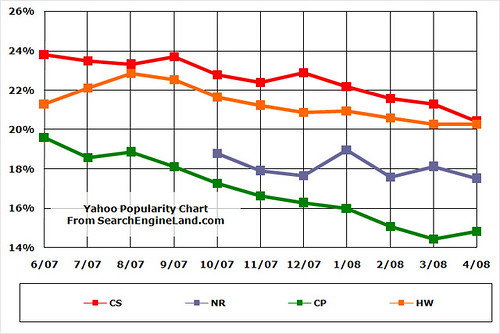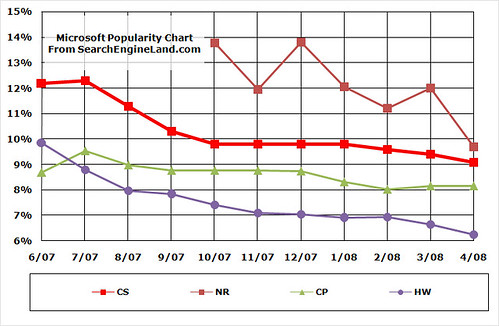Search Share Compared: Ratings Service Faceoff, June 2007 To April 2008
With the latest search popularity stats now in from Hitwise, Nielsen, comScore, and Compete, it’s time to pit them against each other and see what they agree — and don’t agree — about in terms of search engine popularity. Why not show a full year’s worth of data? Ratings methodology changes mean I can only […]
With the latest
search
popularity stats now in from
Hitwise,
Nielsen,
comScore, and
Compete, it’s time
to pit them against each other and see what they agree — and don’t agree —
about in terms of search engine popularity.
Why not show a full year’s worth of data? Ratings methodology changes mean I
can only go back to June 2007 for comScore and October 2007 for Nielsen.
Normally I would also show raw number of searches in addition to search
share. See the caveats section below which explains why this is important. However, I don’t have
Compete figures this month. Without them, I didn’t want to generate charts with
data only from Nielsen and comScore. Those charts will return next time.
Services shown in the charts blow:
- CS stands for comScore
- NR stands for Nielsen Online
- HW stands for Hitwise
- CP stands for Compete
The charts show the share of searches in the United States that each ratings
service estimates each search engine to have. In other countries, shares will be
different — often dramatically so.
Finally, the charts use different scales. Rather than running them all from
zero to 100 percent, I’ve tightened them between low and high marks unique to
each service. This can make ups-and-downs seem more dramatic, but it also means
you can better see specific changes with each service.
What, you were expecting a decline? Google’s exact share may differ from
ratings service to ratings service. But everyone agrees — Google’s going up,
up, up.
Yahoo
Yes, Yahoo’s seeing declines overall — though in raw number of searches (see
Nielsen and
comScore), it pretty
much has stayed the same. It’s not that Yahoo is losing search traffic. Google’s
getting more of new traffic.
Microsoft
Everyone now gives Microsoft less than 10 percent share of the US market. In
terms of raw searches, the picture’s similar to Yahoo, where Microsoft is
largely keeping the same number of searches.
Caveat Time!
As a reminder, my general rules when evaluating popularity stats:
- Avoid drawing conclusions based on month-to-month comparisons. Lots
of things can cause one month’s figures to be incomparable to another month.
It’s better to see the trend across multiple months in a row.
- Avoid drawing conclusions based on one ratings service’s figures.
Each service has a unique methodology used to create popularity estimates.
This means that ratings will rarely be the same between services. However, a
trend that you see reflected across two or more services may give you faith in
trusting that trend.
- Consider Actual Number Of Searches: While share for a particular
search engine might drop, the raw number of searches might still be going up
(and thus they might be earning more money, despite a share drop). This is
because the "pie" of searches keeps growing, so even a smaller slice of the
pie might be more than a bigger slice in the past.
Opinions expressed in this article are those of the guest author and not necessarily Search Engine Land. Staff authors are listed here.
Related stories
New on Search Engine Land


